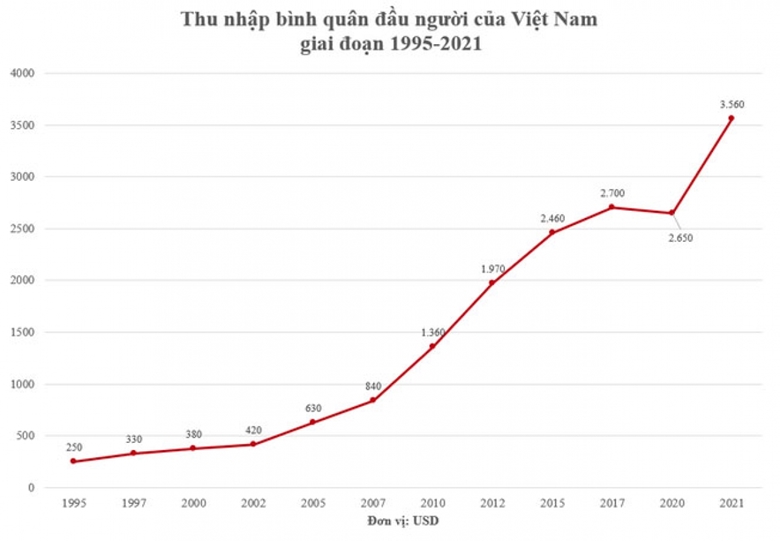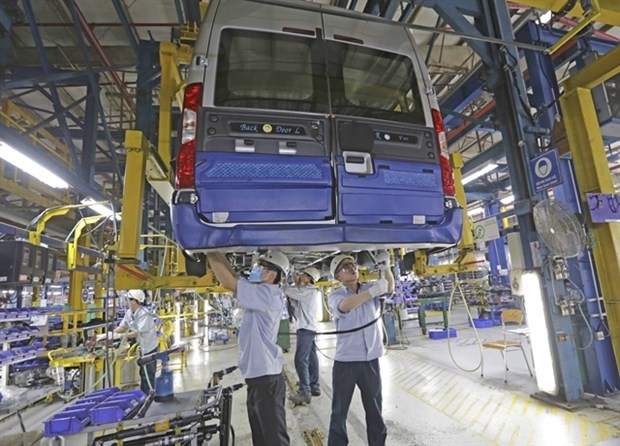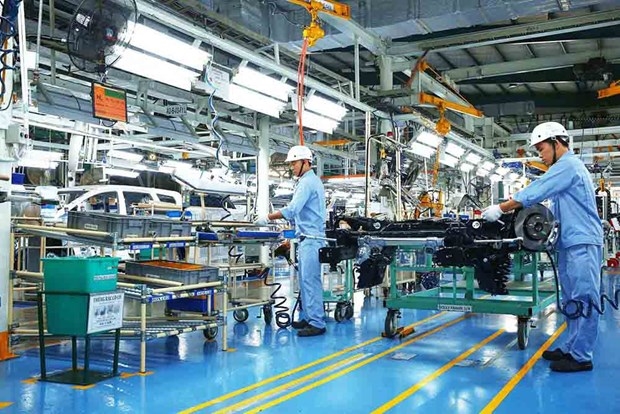 |
| Vietnam’s per capita income during 1995-2021 period (Photo: WB) |
In 1995 Vietnamese per capita income was USD250, ranking ninth out of 10 countries in Southeast Asia, just above Myanmar with USD90. Meanwhile, Singapore was the country with the highest per capita income, reaching USD23,630.
However, 1997 saw Vietnamese per capita income surpass that of Cambodia to rank eighth in the region. At this time, the country’s per capita income was about USD330, higher than Myanmar’s USD130 and Cambodia’s USD320.
Throughout the 1997 to 2021 period, Vietnam surpassed Myanmar, Cambodia, and Laos, to rank in seventh position. Last year witnessed its average income per capita reach USD3,560 annually. However, the country remained behind the likes of Singapore, Brunei, Malaysia, Thailand, Indonesia, and the Philippines.
Most notably, between 1995 and 2021 the country’s average income increased more than 14 times, representing the highest rise in ASEAN. This figure shows Vietnam has actively developed its economy and improved the overall quality of life for local people.
In the 2021 - 2025 period, the country will seek to improve labour productivity, apply scientific and technological advances, and enhance the overall quality of human resources.
Vietnamese trade surplus to EU reaches USD15.5 billion in H1
The nation’s export value to the EU grew further in the first six months of this year, resulting in a trade surplus of USD15.5 billion, a rise of nearly 39%, thanks to the bilateral free trade agreement in place between the two sides, reported the Voice of Vietnam.
Statistics highlight that total trade between Vietnam and the EU stood at an estimated USD31.7 billion in the first half of the year.
Of the figure, Vietnam exported USD23.6 billion worth of goods to the bloc, while it imported USD8.1 billion worth of products from the lucrative market.
The Netherlands, Germany, Italy, Belgium, France, Spain, and Austria represent key markets in the region importing Vietnamese commodities.
Most notably, exports picked up on items such as cashew nuts, coffee, vegetables, fruit, fishery products, rice, and timber products.
These positive signs are attributable to the EU - Vietnam Free Trade Agreement (EVFTA) which took effect from August 1, 2021. Vietnamese exports continued to expand despite the lingering impact of the COVID-19 pandemic coupled with the Russia-Ukraine conflict which has pushed material and fuel prices up, as well as rising transportation costs.
Nearly 90% of population covered with health insurance
More than 86.8 million people, or 88.99 percent of the population, had been covered with health insurance by the end of June, reported Vietnam News Agency according to the Vietnam Social Security (VSS).
 |
| Many hospitals nationwide have been equipped with advanced machinery to serve medical examination and treatment. (Photo: VNA) |
Addressing a conference on July 8, VSS Deputy General Director Dao Viet Anh said the health insurance policy has increasingly affirmed its role in society, noting that it has benefited more than 100 million turns of people coming to medical establishments for examination and treatment each year.
In 2020 - 2021, the health insurance fund joined the State budget to greatly help with COVID-19 prevention and control as well as pandemic aftermath settlement, thus continuing to assert the health insurance policy’s role as a pillar of the national social security system.
By the end of June, more than 17.1 million people had participated in social insurance, equivalent to 33.87% of those in the working age and rising 6.16% from the same period last year. They include nearly 1.5 million taking part in voluntary social insurance.
Meanwhile, nearly 14 million people, or 27.55% of the workforce, had been covered with unemployment insurance, up 5.13% year on year, statistics showed.
Anh said giving the top priority to insurance participants’ rights and interests, the VSS has actively worked with relevant ministries and sectors to provide maximum support for them to gain insurance benefits.
Its system delivered social, health and unemployment benefits to nearly 6.3 million turns of people in the first half of this year, he added.
Industrial production up 8.48 % in H1
The index of industrial production (IIP) in the first half of this year surged 8.48% over the same period last year, reported Vietnam News Agency according to the General Statistics Office (GSO).
 |
| Passenger cars are being manufactured at the Ford Hai Duong factory. (Photo: VNA) |
The GSO said that the IIP in the second quarter also saw a positive increase of 9.87% year-on-year as many industrial firms have resumed and gradually recovered their business activities.
During the six months, the processing and manufacturing industry posted the highest industrial output growth of 9.66%. It was followed by electricity generation and distribution (6.51%), electricity production and distribution (6.1%) and the mining industry (2.28%).
Key industries that recorded high increases in H1 include clothing, up 23%; electrical equipment (22%); pharmaceutical and medical materials (17.5%); leather (13%); and electronics, computers and optical products (11%).
On the contrary, several industries saw a decline in industrial production, such as repair, maintenance and installation of machinery and equipment, down 11%; rubber and plastic products (8.5%); coke and refined petroleum products (1.4%) and crude oil and natural gas (1.2%).
Several key industries recorded high growth in the period, including clothes (up 22%); electricity equipment (20.4%); leather and leather products (13.5%); electronics, computers and optical devices (11.6%); and metal production (11.5%).
The GSO also named key industrial products with strong IIP increases, including telephone components with 22%; beer (14%); urea fertiliser (13.5%); processed seafood and automobiles (12%) and clean coal (10%).
Some products decreased compared to the previous year, such as televisions (18%); aquatic feed (7%); mobile phones (4.3%); NPK fertiliser (4%) and motorbikes (3.5%).
From January to June, the IIP rose in 61 out of 63 provinces and cities, with significant growth seen in several localities, which experienced a strong recovery in the manufacturing and processing industry thanks to the successful containment of COVID-19 such as Bac Giang (46%); Lai Chau (45%); Quang Nam (25%) and Ha Giang (24%).
According to the GSO, the consumption index of the processing and manufacturing industry in H1 rose 9.4% compared to last year's corresponding period. In June, the index dropped 1% month-on-month and advanced 9.4% year-on-year.
The average inventory rate of the processing and manufacturing industry in the six months was 78%, much lower than the 92% recorded in the same period last year, the GSO noted.
As of June 1, the number of employees working in industrial enterprises rose 1.3% over the previous month and 5.8 % compared to the same month last year.
The number of employees in State-owned enterprises decreased 4.8% year-on-year, while those in non-State firms slumped 0.3%, and those in foreign-invested businesses increased by 7%.
 |
| Illustrative photo (Source: VNA) |
Manufacturing sector expansion
According to S&P Global, the Vietnamese manufacturing sector ended the first half of 2022 firmly in expansion mode as a lack of disruption from the COVID-19 pandemic supported demand and production.
Firms were also increasingly successful in hiring additional staff, with the rate of job creation quickening to a three-and-a-half-year high, S&P Global said in a report released last week.
Further marked increases were seen in both output and new orders at the end of the second quarter, as relative market stability due to a lack of pandemic disruption enabled demand to grow, adding that rates of expansion were particularly pronounced in the consumer goods category.
Rising new orders encouraged manufacturers to expand workforce numbers again during June, extending the current sequence of increasing staffing levels to three months.
“The Vietnamese manufacturing sector ends the first half of 2022 in good health, with firms feeling that they've seen the back of the pandemic and can generate new business at a solid rate," Andrew Harker, Economics Director at S&P Global Market Intelligence, said.
The country's Manufacturing Purchasing Managers' Index (PMI) posted 54.0 in June, down slightly from 54.7 in May but still signalling a solid monthly improvement in the health of the sector, according to S&P Global./.